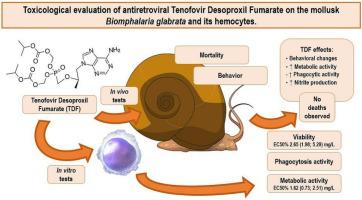Science of the Total Environment ( IF 8.2 ) Pub Date : 2023-05-29 , DOI: 10.1016/j.scitotenv.2023.164484 Gabriel Souza-Silva 1 , Clessius Ribeiro Souza 1 , Cíntia Aparecida de Jesus Pereira 2 , Walter Dos Santos Lima 2 , Marcos Paulo Gomes Mol 3 , Micheline Rosa Silveira 1

|
Tenofovir disoproxil fumarate (TDF) is a drug used in HIV treatment, and several studies have detected its presence in surface water. Furthermore, more information on its environmental impact is needed in the scientific literature. Thus, due to the lack of data on the impact of this drug, and its presence in different waters of the world, this work aimed to evaluate the potential toxicological effects of TDF on the mollusk Biomphalaria glabrata in vivo and in vitro. For in vitro analysis, hemocytes were exposed to different drug concentrations for 1 h and evaluated for feasibility, and phagocytic and metabolic activity. The in vivo analysis consisted of the exposure of groups of five mollusks, in triplicate, at the same drug concentrations for 72 h and 21 days, evaluating mortality, and mollusk and hemolymph behavior. Although the exposure of the mollusk to TDF did not reduce its survival, however it was toxic to its hemocytes. Even if toxicity was identified on the mollusk and its hemocytes initially, further studies should be conducted to understand the effects of this residue on the environment and different life stages of the mollusk because, per the Globally Harmonized System of Classification and Labeling of Chemicals, for aquatic ecosystems, the results obtained were classified as toxic (EC50% 2.65 [1.98; 5.29] mg/L) and could cause unfeasibility in hemocytes at concentrations below 10 mg/L.
中文翻译:

抗逆转录病毒药物富马酸替诺福韦二吡呋酯对软体动物光滑双脐及其血细胞的毒理学评价
富马酸替诺福韦二吡呋酯 (TDF) 是一种用于治疗 HIV 的药物,多项研究已检测到其在地表水中的存在。此外,科学文献中需要更多关于其环境影响的信息。因此,由于缺乏关于该药物的影响及其在世界不同水域中存在的数据,本工作旨在评估 TDF 对软体动物光滑生物脐的体内和体外潜在毒理学影响。对于体外分析,将血细胞暴露于不同药物浓度下 1 小时,并评估可行性以及吞噬和代谢活性。体内_分析包括五种软体动物一组,一式三份,在相同的药物浓度下暴露 72 小时和 21 天,评估死亡率以及软体动物和血淋巴行为。尽管软体动物接触 TDF 并不会降低其存活率,但对其血细胞具有毒性。即使最初在软体动物及其血细胞上发现了毒性,也应该进行进一步的研究,以了解这种残留物对环境和软体动物不同生命阶段的影响,因为根据全球化学品统一分类和标签制度,对于水生生态系统中,获得的结果被归类为有毒(EC50% 2.65 [1.98; 5.29] mg/L),浓度低于 10 mg/L 时可能导致血细胞不可行。






























 京公网安备 11010802027423号
京公网安备 11010802027423号